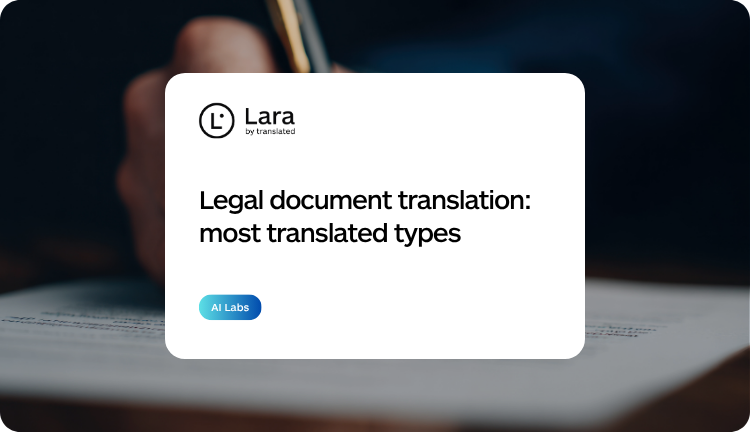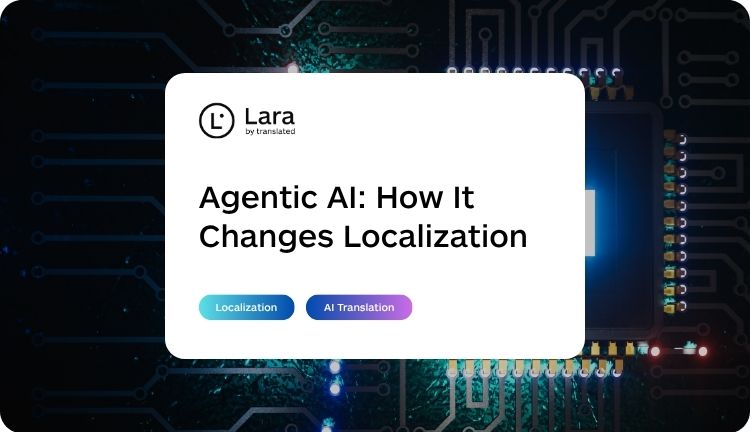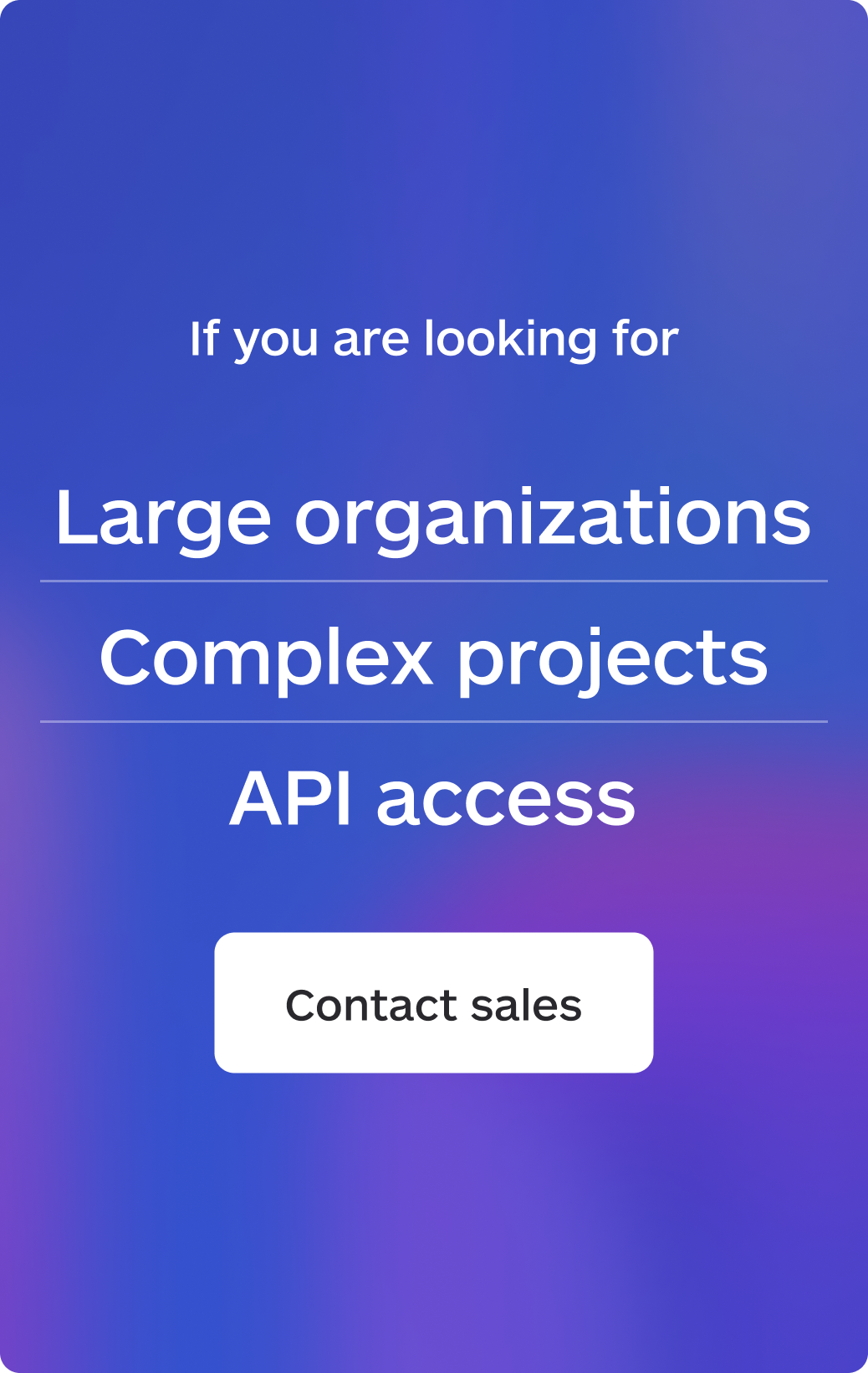Legal Document Translation Requirements: A Practical Guide for Law Firms
When your law firm receives a stack of legal documents in multiple languages, handling them correctly becomes mission-critical. A misplaced comma in a contract translation or an improperly certified immigration document can derail cases, damage client relationships, and expose your firm to liability. Understanding which legal document translation requirements apply to each document type helps you navigate this complex landscape with confidence.
This guide examines the most frequently translated legal materials, from contracts to court filings, and provides practical strategies to handle each one properly. Whether you’re managing international litigation, processing immigration paperwork, or reviewing multilingual business agreements, you’ll find actionable approaches to maintain accuracy, meet certification requirements, and protect confidentiality throughout the translation process.
TL;DR
|
Translate Legal Documents Now with Lara Translate
Business contracts and agreements
| Document type | When needed | Certification required | Typical pitfalls | Turnaround expectations | Who should translate |
|---|---|---|---|---|---|
| Business contracts & agreements | Cross-border deals, vendors, employment, licensing, due diligence packs. | Usually translator certification on request; notarization for closings; apostille if used abroad as public records. | Defined terms, cross-refs, choice-of-law/venue, IP scope, numbers/dates, inconsistent terminology. | Short docs 24–72h; MSAs/SLAs staged over days–weeks with legal redlines. | Contract-law translator + lawyer review; glossary/TM enforced. |
Commercial contracts represent one of the highest-volume categories in legal document translation. Companies expanding internationally need to translate contracts and agreements for partnerships, vendor relationships, employment arrangements, and licensing deals. These documents carry significant financial and legal weight, making accuracy non-negotiable.
The challenge with contracts lies in their precision requirements. A single mistranslated clause about liability limits, payment terms, or intellectual property rights can shift the entire balance of an agreement. Contract translations must preserve not just the literal meaning but the legal intent and effect of each provision. Research indicates that translation errors in business contracts contribute to substantial financial losses through legal disputes, broken partnerships, and invalidated agreements, underscoring the importance of professional handling.

When handling business contracts, pay particular attention to defined terms, which often carry specific meanings that differ from common usage. A “Material Adverse Change” clause in English, for example, has precise legal implications that must be rendered with equal specificity in the target language. Similarly, jurisdictional references and choice-of-law provisions require careful handling to reflect the appropriate legal frameworks.
For comprehensive guidance on maintaining accuracy throughout the contract translation process, review these essential best practices for translating legal documents.
Court documents and litigation materials
| Document type | When needed | Certification required | Typical pitfalls | Turnaround expectations | Who should translate |
|---|---|---|---|---|---|
| Court docs & litigation | Pleadings, motions, exhibits, discovery, witness statements, depositions. | Court-accepted certified translation; some courts require notarization/specific wording. | Tone/certainty (“think” vs “saw”), exhibit/page-line refs, formatting rules, confidentiality markings. | Deadline-driven; urgent filings 24–48h; bulk discovery via batching + QA. | Court-experienced legal translator; supervising attorney compliance check; secure no-retention flow. |
Court filings, pleadings, motions, and discovery materials frequently cross language barriers in international litigation and cases involving non-English-speaking parties. These documents face strict filing deadlines and formatting requirements that vary by jurisdiction, adding complexity to the translation process.
Courts often require certified legal translation services for documents submitted as evidence or filed with the court. The certification process typically involves a signed statement from the translator attesting to their qualifications and the accuracy of the translation. Some jurisdictions mandate additional notarization or specific certification formats, so verifying local requirements before beginning translation saves time and prevents rejected filings.
Depositions, witness statements, and expert reports present unique challenges because they capture spoken testimony. Translators must convey not just the words but the tone, certainty level, and potential ambiguities in the original statement. A witness who says “I think I saw” versus “I definitely saw” communicates very different information, and the translation must preserve these nuances.
Discovery materials, particularly in large-scale litigation, can involve thousands of pages requiring translation. Technology-assisted review and translation memory systems help manage these volumes while maintaining consistency in terminology across documents.
Immigration documents
| Document type | When needed | Certification required | Typical pitfalls | Turnaround expectations | Who should translate |
|---|---|---|---|---|---|
| Immigration documents | Birth/marriage certs, police records, diplomas/transcripts, employment letters. | Certified translation with authority-specific wording (e.g., USCIS); notarization sometimes; apostille for cross-border public docs. | Name/date mismatches, transliteration, seals/stamps, grading scales, incomplete certifications. | Short docs 24–72h; allow buffer for agency checks/RFEs. | Certified translator versed in immigration rules; paralegal/attorney verifies consistency across the file. |
Immigration papers represent another high-frequency category of translated legal materials. Birth certificates, marriage certificates, academic transcripts, employment records, and police clearances all require translation for visa applications, citizenship proceedings, and immigration court cases.
Immigration authorities typically mandate certified translations for these documents, and many specify exact certification formats. The U.S. Citizenship and Immigration Services (USCIS), for example, requires a signed certification statement that includes specific language about the translator’s competency. Failure to meet these technical requirements leads to application delays or rejections, regardless of translation quality.

The stakes in immigration cases make accuracy particularly crucial. An error in a birth date, name spelling, or relationship status can create inconsistencies across an application that raise red flags for reviewers. These discrepancies can delay processing by months or even result in application denials.
Personal documents like academic transcripts present additional challenges because they often include institution-specific terminology, grading systems, and degree classifications that don’t translate directly. A translator must understand both educational systems to render these documents accurately while providing necessary context for reviewers unfamiliar with the source country’s academic structure.
Intellectual property documents
| Document type | When needed | Certification required | Typical pitfalls | Turnaround expectations | Who should translate |
|---|---|---|---|---|---|
| Intellectual property (patents, trademarks, copyright) | PCT/national phase, office actions, specs/claims, TM filings & evidence. | IPO-specific; sworn/certified translations sometimes required for claims/priority. | Claim scope (“comprising/consisting”), terminology consistency, figure refs, units, false friends. | Specs often multi-week; rushes around statutory deadlines; iterative counsel QC. | Patent-specialized translator; patent attorney final review; strict TM/glossary control. |
Patents, trademarks, and copyright registrations frequently require translation for international protection. Patent translations demand particular technical expertise because they combine legal precision with highly specialized technical content. A mistranslated claim in a patent application can narrow or invalidate the protection sought, potentially costing millions in lost intellectual property rights.
Patent claims use a specific linguistic structure designed to define the scope of protection precisely. Terms like “comprising,” “consisting of,” and “consisting essentially of” carry distinct legal meanings in patent law, and their equivalents in other languages must convey the same scope limitations. Many languages lack direct equivalents for these terms, requiring translators with deep patent law knowledge to select appropriate alternatives.
Technical terminology in patents adds another layer of complexity. A patent for a pharmaceutical compound or semiconductor device may contain hundreds of specialized terms that must be translated consistently and accurately. Translation memory systems become particularly valuable here, ensuring that the same technical term receives the same translation throughout a lengthy patent specification.
International patent applications through the Patent Cooperation Treaty (PCT) system require translations into multiple languages, each conforming to specific formatting and technical requirements of different patent offices. Managing these translations requires coordination across multiple jurisdictions while maintaining technical accuracy and legal precision.
Corporate governance documents
| Document type | When needed | Certification required | Typical pitfalls | Turnaround expectations | Who should translate |
|---|---|---|---|---|---|
| Corporate governance | Articles/bylaws, shareholder agreements, minutes/resolutions, regulator/bank packs. | Often certified for filings; notarization possible; apostille for cross-border use. | Voting rights, drag/tag-along, transfer restrictions, quorum/dates, titles/signature blocks. | Closings/board cycles 24–96h; plan for sign-off loops. | Corporate-law translator; counsel validation; controlled terminology across records. |
Articles of incorporation, bylaws, shareholder agreements, and board resolutions require translation when companies operate across borders or involve foreign investors. These documents establish the legal structure and operating rules of an organization, making accuracy essential for corporate compliance and governance.
Shareholder agreements present particular challenges because they often include complex provisions about voting rights, transfer restrictions, drag-along and tag-along rights, and dispute resolution mechanisms. These concepts may not exist in identical forms across different legal systems, requiring translators to find appropriate equivalents while explaining any differences in legal effect.

Board resolutions and meeting minutes require translation for multinational corporations and companies with foreign subsidiaries. These translations must be completed promptly to enable timely decision-making and maintain proper corporate records. Many jurisdictions require certified translations of these documents for filing with government agencies or when transferring property or making significant corporate changes.
Real estate documents
| Document type | When needed | Certification required | Typical pitfalls | Turnaround expectations | Who should translate |
|---|---|---|---|---|---|
| Real estate | Deeds, leases, purchase agreements, title reports, easements, HOA bylaws. | Usually certified for registries/banks; sworn translations or notarization may be locality-required. | Metes & bounds, servitudes/easements, fee simple vs civil-law concepts, currency/dates, annexes. | Deal-driven; simple leases 24–72h; title packs staged with QC. | Real-estate legal translator; counsel checks notary/registry rules pre-filing. |
Property deeds, leases, purchase agreements, and title documents cross language barriers frequently in international real estate transactions. These documents carry significant financial implications and create lasting legal obligations, demanding careful translation.
Real estate terminology varies considerably across jurisdictions, reflecting different property law systems and local practices. A “fee simple” ownership interest in common law jurisdictions doesn’t directly correspond to property rights concepts in civil law countries. Translators must understand these differences and explain any gaps or variations in the translated document.
Property descriptions in deeds and titles often include highly technical surveying terminology, legal descriptions based on specific reference systems, and easement language that must be rendered precisely. An error in translating property boundaries or access rights can create title defects that persist for years and potentially invalidate transactions.
How Lara Translate streamlines legal document translation
Managing legal document translation efficiently while maintaining quality and security requires specialized technology designed for professional use. Lara Translate addresses the unique demands of legal translation through features specifically developed for business and professional contexts.
Built on professionally reviewed translation datasets, Lara Translate delivers contextual accuracy optimized for legal and business content. The platform supports a growing list of languages, addressing the performance gaps often seen in general translation tools when handling non-English language pairs. This capability proves particularly valuable for law firms working with clients and matters spanning multiple jurisdictions.
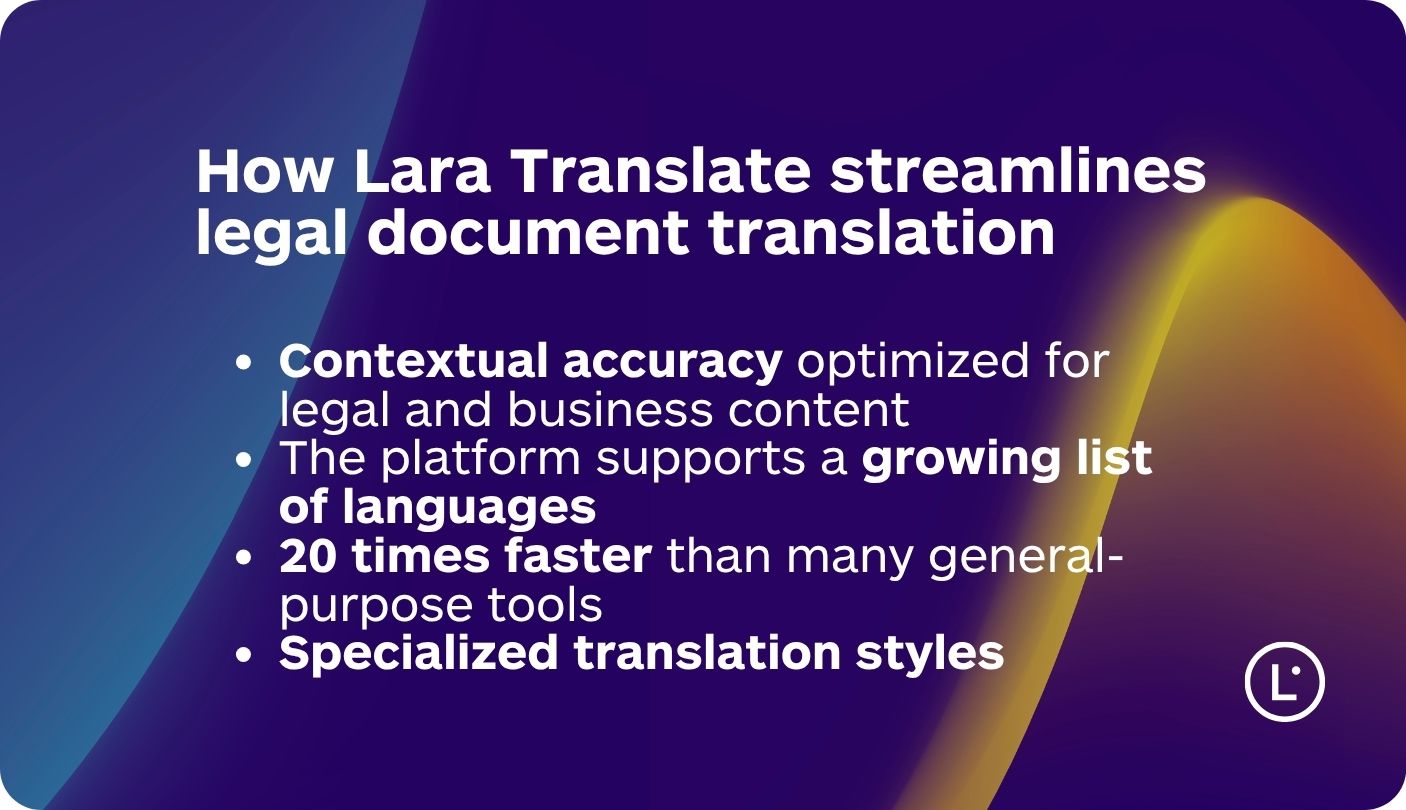
Speed matters in legal work, especially when facing court deadlines or time-sensitive transactions. Lara Translate achieves translation speeds approximately 20 times faster than many general-purpose tools, with 99% of translations completing in 1.2 seconds. This efficiency enables legal teams to handle larger document volumes without sacrificing quality or missing deadlines.
For legal professionals who need precision in terminology and structure, Lara Translate offers specialized translation styles. The Faithful style prioritizes maintaining the original document’s structure and meaning, which proves essential for legal and technical documents where preserving linguistic accuracy and format matters most.
Translate Legal Documents Now with Lara Translate
Security, workflow management, and professional support
Data security and confidentiality represent paramount concerns in legal work. Lara Translate provides two distinct translation modes to address varying confidentiality requirements. Learning Mode uses encrypted translations to improve the system over time, while Incognito Mode ensures that no translation data is stored—ideal for highly sensitive legal documents where confidentiality is critical. This flexibility allows legal teams to choose the appropriate level of data handling for each document type.
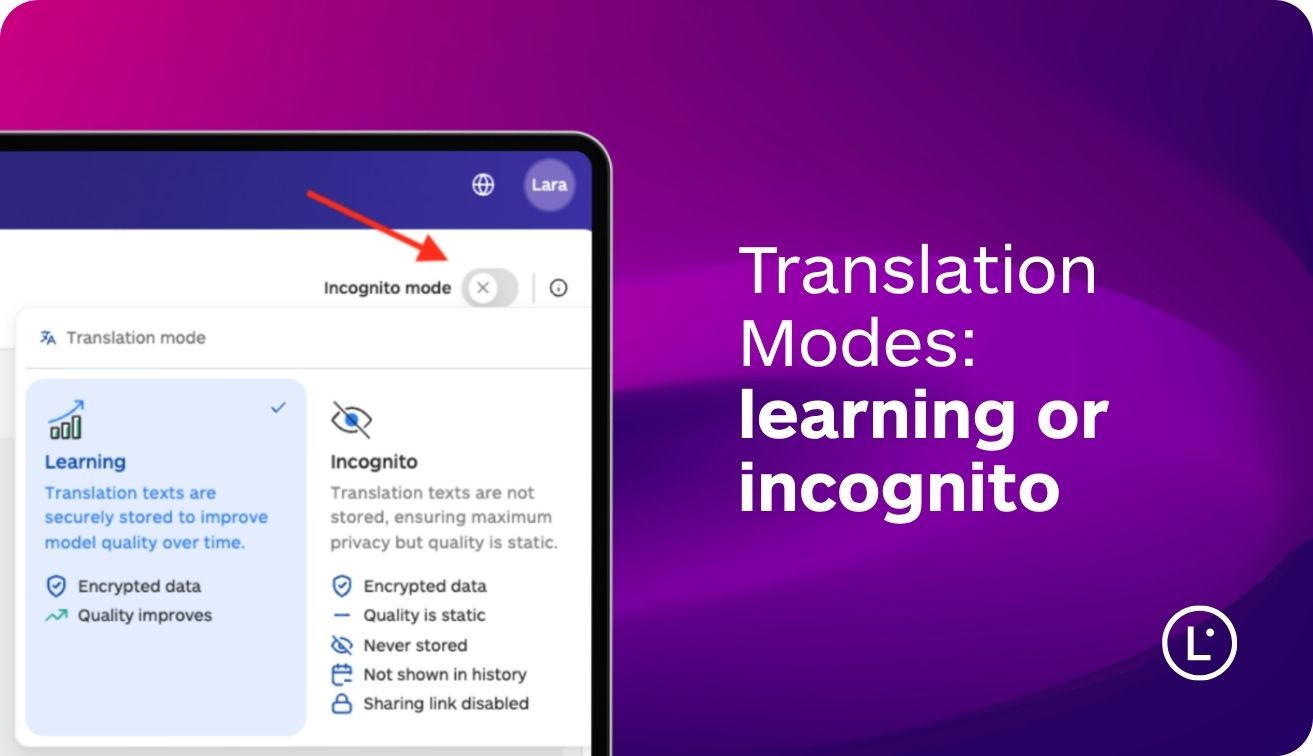
For firms managing translation workflows across multiple matters and team members, Lara Translate offers project management capabilities and team collaboration features. Legal professionals can upload documents in over 53 file formats while preserving original layouts, track translation progress, and maintain consistent terminology across cases. When working with company-specific legal terminology or preferred phrasings, the platform can adapt using custom glossaries and translation memories.
When sensitive content requires additional oversight, professional human review services are available through Translated, the global language solutions provider behind Lara Translate. This ensures access to a network of professional translators when cases demand certified translations or specialized legal expertise. While AI-powered translation technology like Lara Translate significantly improves efficiency and consistency, human legal expertise remains essential for complex legal documents. The most effective approach combines AI translation for initial drafts and high-volume processing with professional legal review for accuracy, cultural nuances, and jurisdiction-specific requirements.
Understanding both the technical capabilities and the ethical considerations of AI translation in regulated industries helps legal teams deploy these tools responsibly while maintaining compliance with data protection requirements and professional standards.
5 best practices for handling translated legal documents
Successfully managing legal document translation requires systematic approaches that address accuracy, certification, and confidentiality throughout the process. These practices help legal professionals minimize risk while meeting client and court requirements.
1. Work with qualified legal translators
Legal translation requires specialized expertise beyond general language proficiency. Professional legal translators understand both the terminology and the underlying legal concepts in source and target languages. They recognize that legal systems vary across jurisdictions and can identify when a direct translation might not convey the correct legal meaning.
When selecting translators or translation providers, verify their experience with the specific type of legal document you need translated. A translator experienced in corporate law may lack the specialized knowledge needed for patent applications or immigration documents. Ask for samples or test translations to evaluate quality before committing to large translation projects. For insights on selecting the right technology and teams for your legal practice, explore the best AI tools designed specifically for legal teams.
2. Ensure proper certification when required
Many legal contexts require certified legal translation services, but certification requirements vary by jurisdiction and use case. Some courts accept a simple certification signed by the translator, while others mandate notarization or specific certification language. Immigration authorities often have detailed certification requirements that must be followed exactly.
Research the specific certification requirements for your jurisdiction and use case before beginning translation. When working with courts or government agencies, check their websites or contact the clerk’s office to confirm current requirements. Requirements sometimes change, and outdated information can lead to rejected filings.
For international matters involving multiple jurisdictions, determine whether apostille certification is needed under the Hague Convention. This additional authentication step verifies the signature and seal on certified documents for use in foreign countries that are parties to the convention.
3. Maintain confidentiality and data security
Legal documents contain sensitive information protected by attorney-client privilege and confidentiality requirements. When engaging translation services, verify their security protocols and confidentiality safeguards. Professional translation providers should sign confidentiality agreements and implement robust data security measures.
Cloud-based translation tools require particular scrutiny. Understand where and how your documents are stored, who has access to them, and whether the data is encrypted. Some free or consumer-grade translation services retain uploaded documents or use them to train their algorithms, creating unacceptable confidentiality risks for legal work.
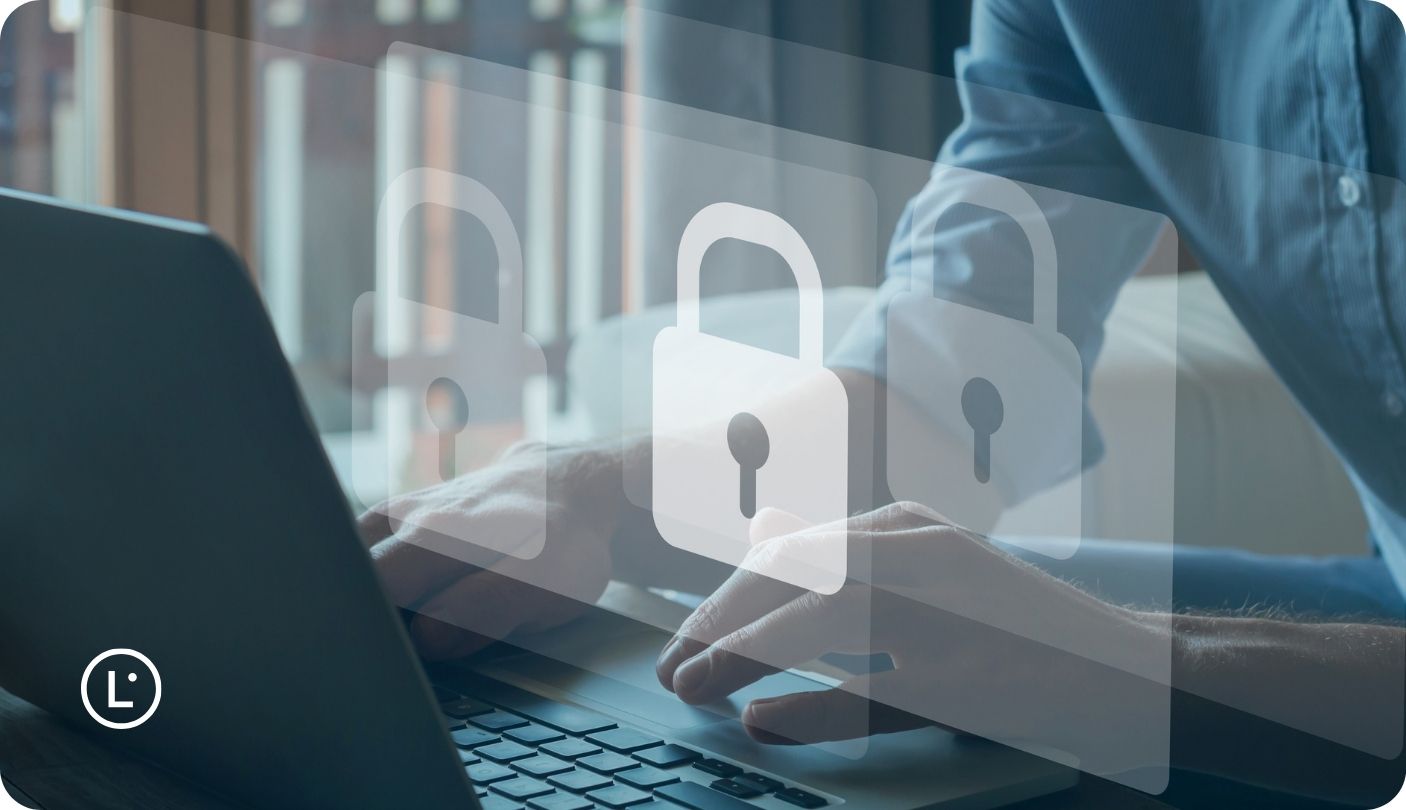
For highly sensitive matters, consider using secure file transfer protocols rather than email attachments. Establish clear document retention and destruction policies with translation providers to ensure translated materials are handled appropriately throughout their lifecycle.
4. Provide context and reference materials
Legal documents rarely exist in isolation. Translators produce more accurate work when they understand the document’s purpose and context. Provide background information about the matter, related documents, and any specific terminology preferences your firm uses.
Create and maintain glossaries of key legal terms used in your practice, with approved translations in the languages you work with frequently. Share these glossaries with translators to ensure consistency across documents and matters. Translation memory systems can automate this process, applying previously approved translations to new documents.
When documents reference laws, regulations, or legal concepts, provide translators with citations or explanations. This context helps them select appropriate terminology and identify potential translation challenges that may require legal input.
5. Build in time for review and revision
Even expert translators produce work that benefits from review, especially for complex legal documents with significant stakes. Build sufficient time into your workflow for a qualified reviewer to check the translation against the original document. For critical documents, consider having a second translator review the work independently.
The reviewer should verify not just linguistic accuracy but legal accuracy. Does the translation preserve the legal meaning and effect of the original? Are all defined terms translated consistently? Do any provisions require explanatory footnotes to account for differences between legal systems?
When revisions are needed, communicate clearly with the translator about the specific issues identified. This feedback improves future translations and helps translators understand your firm’s requirements and preferences.
Translate Legal Documents Now with Lara Translate
Ensuring accuracy in technical legal terminology
Legal language contains specialized terminology that poses significant translation challenges. Terms of art, Latin phrases, and jurisdiction-specific concepts often lack direct equivalents in other languages, requiring translators to make nuanced decisions about how to convey meaning accurately.
Some legal terms function as “untranslatables”—concepts so rooted in a particular legal system that no precise equivalent exists in the target language. Common law concepts like “trust” or “estoppel” may require explanatory phrases when translated into languages of civil law jurisdictions. Translators must decide whether to transliterate the term, provide a functional equivalent, or add an explanatory footnote.
Latin legal phrases present similar challenges. Terms like “habeas corpus,” “prima facie,” and “res judicata” are sometimes retained in translation because they’re recognized internationally, while in other contexts they need translation or explanation. The appropriate approach depends on the document’s purpose and audience. When evaluating the most effective tools for translating legal documents, consider how well they handle these specialized terminology challenges.
Numbers, dates, and formatting conventions require particular attention because errors here can have significant legal consequences. Different countries format dates differently (MM/DD/YYYY versus DD/MM/YYYY), which can create ambiguity or errors. Monetary amounts require clear currency identification, and large numbers may need clarification about whether periods or commas serve as decimal separators.
Common pitfalls in legal document translation
Even experienced translators encounter challenges when working with legal materials. Understanding common pitfalls helps legal professionals identify potential issues and implement quality control measures.
Over-literal translation represents a frequent problem in legal work. While fidelity to the source text is essential, purely word-for-word translation often produces awkward or legally inaccurate results. Legal concepts must be understood holistically and rendered in a way that achieves equivalent legal effect in the target language, even when the literal wording differs.
Inconsistent terminology undermines legal documents. When the same legal concept appears multiple times in a document or across related documents, it should receive the same translation each time. Variations in terminology create ambiguity and can lead to questions about whether different legal meanings were intended.

Failure to account for different legal systems causes problems in cross-border matters. A translation that accurately conveys the linguistic meaning may still be misleading if it doesn’t account for how legal concepts differ between jurisdictions. Translators and reviewers must consider whether additional context or explanation is needed to avoid misunderstandings.
Ignoring formatting and structure creates practical problems. Legal documents often have specific formatting requirements, including section numbering, indentation, and cross-references. Translations must preserve these structural elements, updating cross-references appropriately when text length changes.
Building your approach to legal translation excellence
Effective legal document translation emerges from combining the right technology, processes, and human expertise. Law firms that excel in this area develop systematic approaches rather than treating each translation as an isolated task.
Start by assessing your firm’s translation needs and common document types. This analysis helps you identify where to invest in resources, training, and technology. Firms handling high volumes of similar documents benefit more from translation memory systems and customized glossaries, while those working with diverse document types may prioritize access to translators with varied specializations.
Develop clear workflows that specify roles, responsibilities, and quality checkpoints. Who selects translators? Who reviews translations? What happens when errors are identified? Documented processes ensure consistent handling across matters and team members.
Invest in building relationships with qualified translators or translation providers. Translators who understand your firm’s practice areas, terminology preferences, and quality expectations produce better work and require less oversight over time. Consider establishing ongoing relationships rather than selecting translators anew for each project.
Create feedback loops that enable continuous improvement. Track common translation issues, document lessons learned, and share insights across your team. Regular communication with translation providers about your evolving needs and expectations helps them serve you more effectively.
Stay informed about developments in legal translation technology. AI-powered tools continue to improve, offering new capabilities that can enhance efficiency while maintaining quality. Evaluate new tools periodically, but always test them thoroughly before incorporating them into client work.
FAQs
What makes legal document translation different from regular translation?
Legal document translation requires specialized knowledge of legal terminology, concepts, and systems in both source and target languages. Legal translators must understand not just words but the legal meaning and effect of provisions, and they must preserve precision while accounting for differences between jurisdictions. The consequences of errors in legal translation can be severe, including contract disputes, rejected court filings, and denied immigration applications, demanding a level of accuracy beyond general translation work.
When is certified translation required for legal documents?
Courts, government agencies, and immigration authorities frequently require certified legal translation services for documents submitted as official evidence or as part of applications. Specific requirements vary by jurisdiction and use case. Some contexts accept translator certification (a signed statement from the translator), while others require notarization or specific certification language. Always verify requirements with the relevant court or agency before beginning translation to ensure your certified translation meets their specific standards.
How long does it take to translate legal documents?
Translation timelines depend on document length, complexity, language pair, and certification requirements. Simple documents like birth certificates might be translated in a day or two, while complex contracts or patent applications may require weeks. Court deadlines and time-sensitive transactions often drive expedited timelines. When using modern translation technology, initial drafts can be produced quickly, but factor in adequate time for legal review and certification. For planning purposes, discuss realistic timelines with your translation provider based on your specific documents and requirements.
Can AI translation tools handle legal documents accurately?
Modern AI translation technology has advanced significantly and can produce useful drafts of legal documents, particularly for routine materials and high-volume processing. However, human legal expertise remains essential for complex legal work. AI tools may miss nuanced legal meanings, jurisdiction-specific concepts, or context-dependent interpretations that experienced legal translators catch. The most effective approach combines AI technology for efficiency with professional legal review for accuracy, particularly for high-stakes documents like contracts and agreements or court filings.
How can Lara Translate help with legal document translation?
Lara Translate offers features specifically designed for professional legal translation needs. The platform’s Faithful translation style preserves the original structure and meaning essential for legal documents, while supporting over 53 file formats with preserved layouts. For confidentiality-critical work, Incognito Mode ensures no data is stored. Translation speeds enable rapid processing of time-sensitive documents, with most standard translations completing in approximately one second. Legal teams can customize terminology through glossaries and translation memories, and when cases require certified translations or specialized expertise, professional human review services are available through Translated, the company behind Lara Translate.
This article is about
- The most commonly translated categories of legal documents, including business contracts, court filings, immigration papers, patents, and corporate governance materials
- Specific challenges and requirements for handling each type of legal document translation, from technical precision in patents to certification requirements for immigration documents
- Best practices for managing legal translation projects, including working with qualified translators, ensuring proper certification, and maintaining confidentiality throughout the process
- How Lara Translate addresses legal translation needs through specialized AI technology optimized for professional contexts, offering speed, accuracy, and security features designed for legal work
- Common pitfalls in legal translation such as over-literal translation and inconsistent terminology, plus practical strategies for avoiding these issues and maintaining quality across translated legal materials
Have a valuable tool, resource, or insight that could enhance one of our articles? Submit your suggestion
